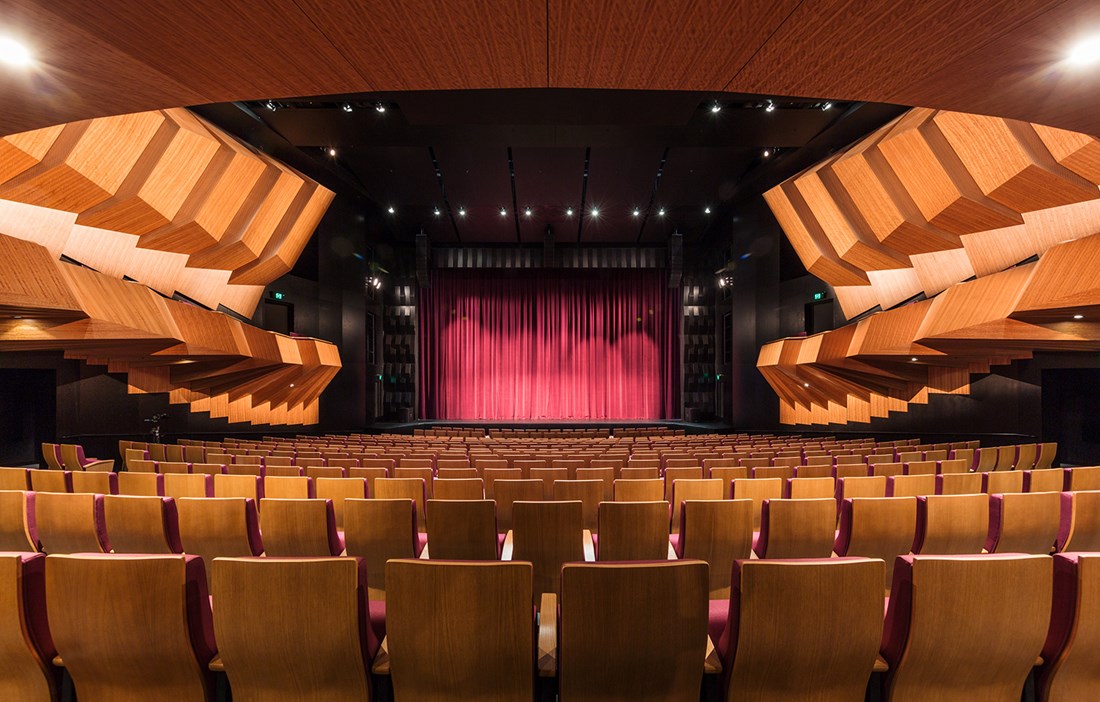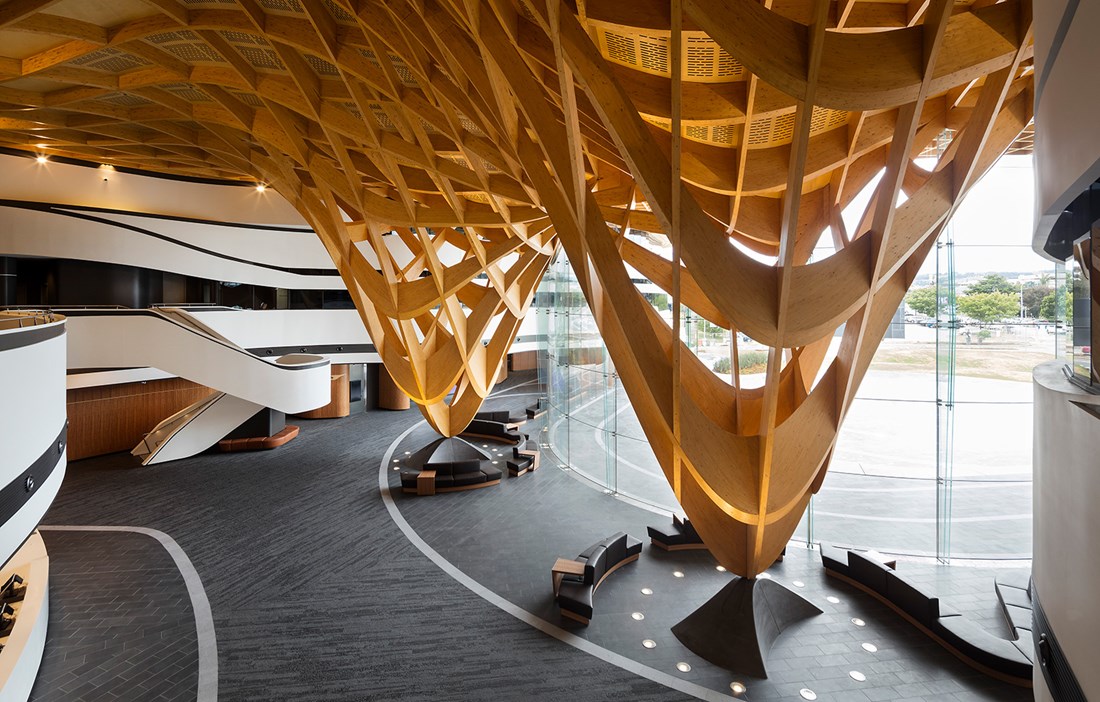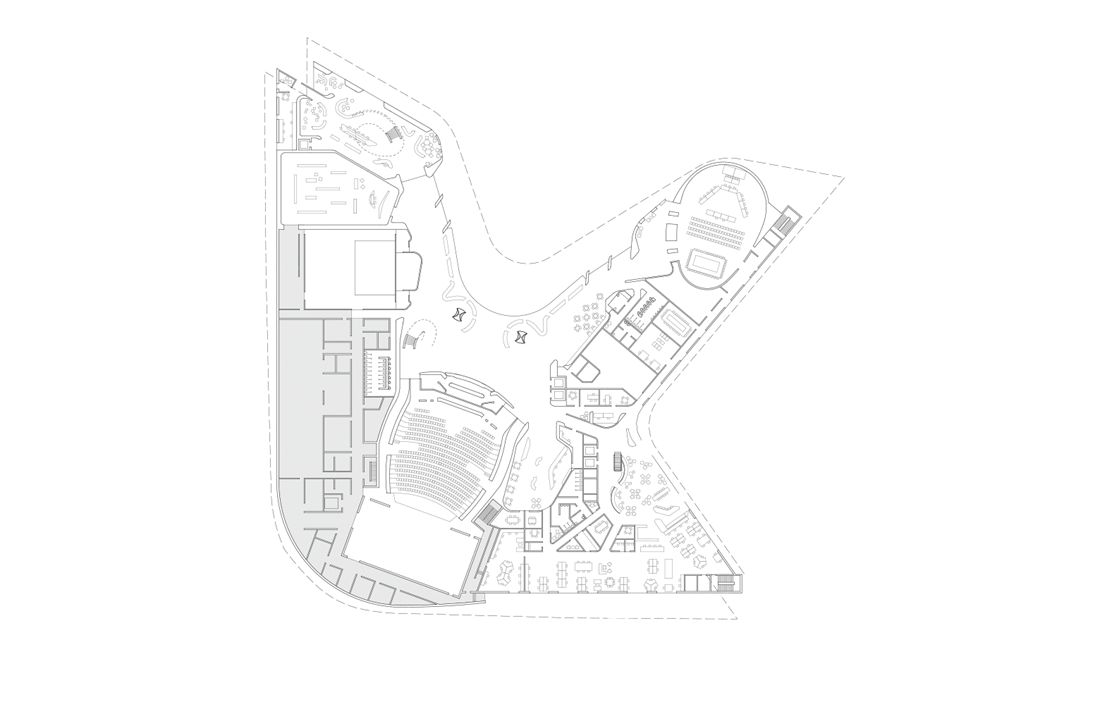The gigantic roof at Bunjil Place is shaped like two eagle wings, a billowing structure in glulam and steel that defines the whole building. Inspired by local Aboriginal mythology, the design connects the rapidly growing area with its history.
Casey City on the outskirts of Melbourne is Australia’s fastest growing municipality. An area that was rural in nature not so long ago is now home to more than 300,000 people. In order to meet the wishes and needs of current and future residents, the local authority began a project to identify what was missing from the area.
What they found was a demand for cultural facilities, meeting places and arenas, a library and functions for local services and information. On this basis, the local authority launched an architectural competition to design a concept that would meet these needs. The winner was the innovative practice FJMT, which has been responsible for several groundbreaking solutions for the public space.
“Our vision was to truly gather all the required functions under one roof. This creates a relevant contemporary solution where we bring together and unite people and build a sense of community in multicultural Casey City,” says Richard Francis-Jones, Design Director at FJMT and chief designer for the project.
A collaboration with the local Aboriginal population was set up early on, which helped to give the building context and connect it to the history of the place. One of the most significant Aboriginal legends from the area is about the eagle Bunjil, the creator who protects the land and welcomes guests, but who also requires guests to follow Bunjil’s laws and not harm the children or the land, which belong to him.
“The story inspired us to design a building with a roof that replicates the shape of a wing span. And in two places we’ve made the wings sweep down and touch the ground,” explains Richard Francis-Jones.
The monumental roof comprises two parts, both of which make a strong contribution to the character of the building. The load-bearing ceiling is constructed as a grillage, a lattice of curved glulam timbers left exposed to give a warm and welcoming feel. On top of this rests the steel roof. Around the inside run mass timber beams that act as the connection between ceiling and exterior roof. There are also intermediate steel plates that help to distribute the forces. The glulam structure then continues down towards the walls, where it switches to concrete, with the load transferred via wooden beams and adjacent steel frames.
“Although the roof and ceiling are structurally connected, they also have a high degree of independence. The glulam lattice is fully self-supporting. The steel roof contains its own load-bearing elements, but is also supported by the concrete walls,” says Richard Francis-Jones.
Either side of the entrance, the wooden grid of the ceiling drops all the way down to the ground at two points, like two legs that taper off and end in stylised talons. In front of the two legs stands the 12 metre-high glass façade, comprising self-supporting curved panes of glass stacked on top of each other and joined using structural adhesive. It is also here that the roof opens up towards the visitors and the building veers off inside to leave an open space outside that forms another meeting place.
Inside the glazed entrance is a large open area that can be used for many different purposes – flexibility of use is a theme that runs throughout the building. As well as the more permanent parts such as the library, café, conference room, theatre, gallery and customer service centre, there are also meeting rooms, meeting places and stages that can be temporarily used for events such as conferences, weddings, dinners, exhibitions, talks, circus and theatre.
Alongside the glulam grid, which is made of Scandinavian spruce, there are also several other visible details in wood. The wooden walls that frame both the foyer and the 800-seat theatre are clad in veneer from a single tree, a huge blackbutt, which is a kind of eucalyptus tree. The tree was found at a sawmill in Queensland that had been saving it until the right project cropped up, which it eventually did.
“The exposed wood on the walls and in the glulam structure creates the warm and welcoming feel that we wanted, in combination with a sense of quality,” states Richard Francis-Jones.
The structure, with its extensive wooden grid system, is unlike anything else in Australia – and has few equivalents globally. In the search for a supplier that was able to handle the complex assignment, FJMT turned to Hess Timber in Germany, where the glulam elements were prefabricated. Every curve in the grid comprises up to 120 laminated lengths of spruce, 6 millimetres thick, with a tolerance of half a millimetre between them. A specialist tool was used to cut out the thin pieces: a six-axis robot that can cut three-dimensional shapes. The connections between the different parts of the grid were then designed to handle the structural pressure on each joint.
“Hess Timber has mainly used what they call Pitzelhängare – concealed hangers with two large locking wood screws between the primary long beams and cross-beams,” says Richard.
The next challenge was about transporting the fragile elements safely.
“To make it work, detailed drawings were produced to show how everything should be packed, not unlike an IKEA flatpack, to make transport as safe and efficient as possible. After three months of transport in containers, they arrived undamaged and then we had a team of local craftsmen to put it all together.”
Initially the building went by the working name of the Casey Cultural Centre, but after a while it became increasingly obvious that it should be given the same name as the mythological eagle it resembles. Now everyone in Casey City knows Bunjil Place. The building is also conveniently located near the motorway and alongside a development with a shopping centre, sports facilities and a swimming pool.
“Many of the people who go shopping on the other side now also stop off here. It’s fantastic to see the way everyone who lives here has really embraced the new building as part of the community,” concludes Richard Francis-Jones.
text Sara Bergqvist


























